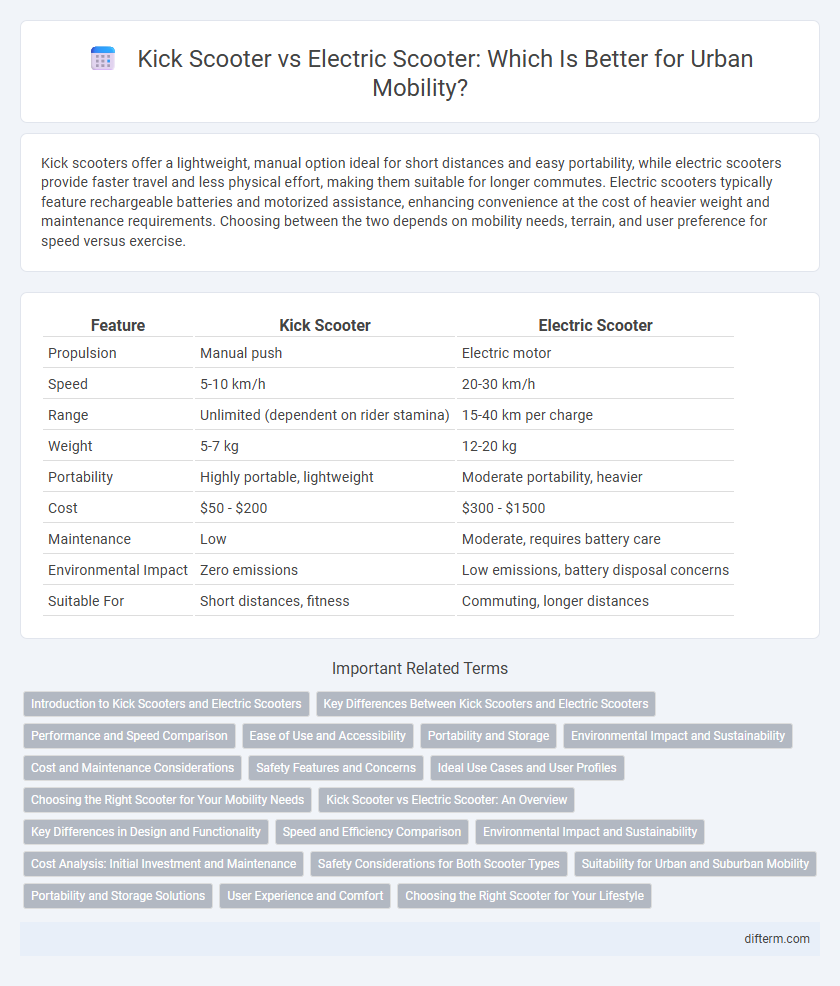Kick scooters offer a lightweight, manual option ideal for short distances and easy portability, while electric scooters provide faster travel and less physical effort, making them suitable for longer commutes. Electric scooters typically feature rechargeable batteries and motorized assistance, enhancing convenience at the cost of heavier weight and maintenance requirements. Choosing between the two depends on mobility needs, terrain, and user preference for speed versus exercise.
Table of Comparison
| Feature | Kick Scooter | Electric Scooter |
|---|---|---|
| Propulsion | Manual push | Electric motor |
| Speed | 5-10 km/h | 20-30 km/h |
| Range | Unlimited (dependent on rider stamina) | 15-40 km per charge |
| Weight | 5-7 kg | 12-20 kg |
| Portability | Highly portable, lightweight | Moderate portability, heavier |
| Cost | $50 - $200 | $300 - $1500 |
| Maintenance | Low | Moderate, requires battery care |
| Environmental Impact | Zero emissions | Low emissions, battery disposal concerns |
| Suitable For | Short distances, fitness | Commuting, longer distances |
Introduction to Kick Scooters and Electric Scooters
Kick scooters are manually powered vehicles with a lightweight frame and small wheels, ideal for short-distance travel and urban commuting. Electric scooters incorporate a motor and battery system that enables faster speeds and longer ranges, making them suitable for longer trips and diverse terrains. Both offer eco-friendly mobility options, with electric scooters providing enhanced convenience through motorized assistance.
Key Differences Between Kick Scooters and Electric Scooters
Kick scooters are manually powered by foot, offering lightweight and compact designs ideal for short-distance commuting and exercise. Electric scooters feature battery-powered motors, enabling higher speeds, longer travel ranges, and easier handling on various terrains. Battery capacity, maximum speed, and maintenance requirements are key differentiators influencing user preference and urban mobility solutions.
Performance and Speed Comparison
Electric scooters typically outperform kick scooters in speed, reaching up to 25 mph compared to the average 10-15 mph of kick scooters. Performance-wise, electric scooters offer enhanced acceleration and hill-climbing capabilities due to their motorized engines, while kick scooters rely solely on rider power. Battery life in electric scooters allows for longer-distance travel without fatigue, distinguishing them from the manual, fitness-oriented use of kick scooters.
Ease of Use and Accessibility
Kick scooters offer lightweight designs and simple mechanics, making them highly portable and easy to use for short distances and uneven terrain. Electric scooters provide enhanced accessibility with motorized support, reducing physical effort and increasing travel range for users of varying mobility levels. Both options contribute to sustainable urban mobility but differ in ease of use depending on user needs and environmental conditions.
Portability and Storage
Kick scooters offer superior portability due to their lightweight design and foldable frames, making them easy to carry and store in small spaces such as backpacks or under desks. Electric scooters, while heavier because of batteries and motors, often feature foldable mechanisms but require more storage room and can be cumbersome to transport over long distances. For urban commuters prioritizing compact storage and quick mobility, kick scooters are generally more practical, whereas electric scooters balance portability with enhanced travel range.
Environmental Impact and Sustainability
Electric scooters produce zero tailpipe emissions, significantly reducing urban air pollution compared to gasoline-powered vehicles, while traditional kick scooters have an even lower environmental impact due to their lack of batteries and electronic components. The production and disposal of electric scooter batteries contribute to resource depletion and potential ecological harm, whereas kick scooters rely solely on human power, eliminating the need for energy consumption beyond physical effort. Choosing kick scooters supports sustainable urban mobility by minimizing carbon footprints and reducing electronic waste, whereas electric scooters offer a balance between convenience and environmental sustainability in short-distance travel.
Cost and Maintenance Considerations
Kick scooters have lower upfront costs, typically ranging from $50 to $150, and require minimal maintenance, mainly involving occasional wheel replacement and brake adjustments. Electric scooters, priced between $300 and $1,200, incur higher maintenance expenses due to battery care, motor servicing, and electronic component repairs. Budget-conscious commuters often prefer kick scooters for their affordability and simplicity, while electric scooters demand a larger investment but offer enhanced mobility and speed.
Safety Features and Concerns
Kick scooters typically lack advanced safety features such as lights, brakes, and durable frames, increasing vulnerability to accidents, especially in low-light conditions. Electric scooters are equipped with LED lights, stronger braking systems, and reinforced frames to enhance rider safety and visibility. However, concerns remain regarding electric scooter battery fires, speed control, and the need for helmet use to mitigate injury risks.
Ideal Use Cases and User Profiles
Kick scooters suit short-distance urban trips and fitness enthusiasts valuing manual control and physical activity, offering lightweight portability for quick errands and smooth pavement. Electric scooters cater to commuters covering longer distances or mixed terrains, ideal for those seeking convenience, speed, and eco-friendly alternatives to cars or public transport. Users prioritizing cost-effectiveness and exercise typically choose kick scooters, while tech-savvy urban professionals prefer electric scooters for daily travel efficiency.
Choosing the Right Scooter for Your Mobility Needs
Kick scooters offer lightweight design and manual control, ideal for short urban commutes and fitness-focused users. Electric scooters provide motorized power, extended range up to 25 miles per charge, and speeds reaching 15-20 mph, making them suitable for longer trips and reduced physical effort. Evaluating factors such as terrain, travel distance, weight capacity, and personal stamina ensures selecting the best scooter aligned with individual mobility requirements.
kick scooter vs electric scooter Infographic

 difterm.com
difterm.com